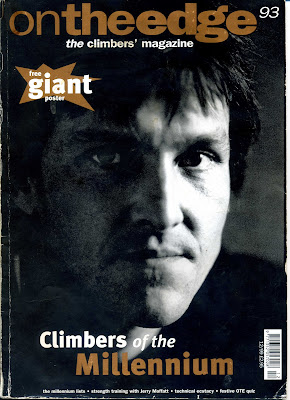
Johnny Dawes’ essentials of elegant motion
“There are so many rock types, so many different climbers it seems improbable there exists a coaching method that could account for all circumstances. The foundation for such a method would have to be a hard and fast rule and there is just such a rule – the equivalent in climbing of the racing line on a racetrack – an easiest, fastest way…”
[Each hold has a particular direction in which it works best. Place your elbow or knee in line with that direction and more purchase from the hold results and progress is easier]
Commonly climbers do two moves every time they make a move to a new hold; one to get the hold and then one to settle onto it in the direction it works best. Start from a very slightly different position, go straight to the sweet spot on the next hold and you do half the moves!
I split my explanation into the What, How and When to move.
What to use:
Select holds furthest away from the plane of the face; sometimes a lesser hold in an outer position makes a move less strenuous.
Spot oppositions; when clamping or bridging becomes involved the stocks, bonds and dividends of legs, back and waist can be used rather than always dipping into the crucial current account of the forearm.
Solve sequence; look at what could be used as a hold, noting which hand it works with, and whether you can use both hands or feet on it.
How to move
It is understandable technique goes wrong so regularly. Already in a position you’re comfortable in, why move anywhere but directly to the next hold. But how you do that makes all the difference. Imagine the easiest shape of your whole body on the next hold and hit that rather than go directly to the hold the easiest way and a host of benefits become clear:
- The move is more likely to be successful.
- To be less injurious.
- To be less wearing.
- To be felt before it happens allowing confidence to
opens up the possibility to feel the fall the move threatens to make, move your body in that very direction first, before moving and the secondary move, complete with it’s skin tearing, tendon straining jolt can be easily avoided. Your body weight will do something, you’d best work out how to move it to your advantage. Imagining the fall that a move unleashes countering it precisely, aiming for best shape on hold rather than just grabbing the hold renders the move less powerful, saving your strength, countering the fear of falling because you can feel how you are controlling it physically. Feeling holds within whole easier shapes the possibility to feel the shape after that quickly means how to build a weight reducing rhythm can
Climb less strenuously – get body weight to move to your advantage rather than just drag you off.
Protect one’s body from injury – by making the moves more gradually impact forces are reduced.
Work out how to do moves you can’t do by hanging on and memorising the feel of being in the position, or using the fall to point out the vectors that are missing from your movement. You can even use this to mentally practise moves you or anyone may never climb, learning their technical lessons.
Dealing with the fear of falling – knowing how you will fall off a move you inject the exactly opposite movement to counter that fall, and too, the fear of it.
Some simplified abridged versions of the dynamic approach.
Sideways weight transferal – swinging weight over a foot to move up the other.
Inward waist thrusts – to stop you peeling back as a hand lets go to reach the other up.
Diagonal rock-over – from out and to the side, to up and over and in, onto the foothold.
Strategy, planning, purchases and research.
Whatever branch of our neurotic little activity tickles your fancy, coalescing what you want to accomplish, how you intend to do it will make adapting to inevitable changing circumstances more successful.
During my new route campaign on the Eastern front of the Peak District I kept a regularly updated list of what I wished to climb. When weather, partner slippage, gear foibles or some other unpredictable might otherwise have frustrated my efforts a clear plan made adapting easy.
Research and buy the best stuff you can afford, borrow it, swap it, use your noodle to get the kit together. Replace before you have to, keeping a lower performance alternative with which to practise handicapped or in the case of boots, which was what was on my mind, more comfortably.
Develop good practises. Clean boots, trim weight away from gear, organise so you can leave the house in a minute, pay bills, pack lunch, stretch to rest etc. Be sensitive to what things power you up and what drags you down. In Kinaesthesiology changing muscle resistance gives away what helps and hinders. Even holding a diet Coke in your other hand reduces the strength of the other so don’t be so sure you already know how everything is. Keep awake to what might help, it might even be a session on the Campus board if you don’t get injured.
All these train spotty details make a difference but more than anything being creative and dogged will out. Turn up and turn out more. Become faster, more precise, stronger with a greater variety of skills, keep note of partners with motors and gites or clever ways to move.
Johnny Dawes
---------------------------------
I will be at Edinburgh film festival 7th October. Please contact me on the following email for any course inquiries: dawesjohnny86@gmail.com or visit www.johnnydawes.co.uk








